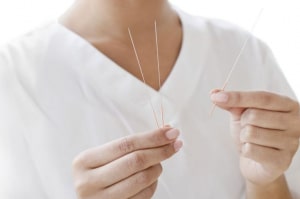Acupuncture For Women’s Health Explained: Top Benefits And Uses

Acupuncture is one of the most effective forms of natural health remedy available. By re-directing and balancing energy, or qi, within the body, acupuncture serves to correct bodily wrongs by addressing their underlying issues. It is a practice that takes years of study and practice to become adept with, and can often heal ailments where traditional medicine cannot.
In this post we’re going to focus on menstruation and the feminine cycle. Cramps, pains, aches, bloating, hormonal imbalance – nearly every woman out there goes through these symptoms, to some degree. So, what mechanism is at work here, and how can acupuncture hope to help these women who positively dread these monthly visits?
What Causes Period Cramping And Pain?

Tampons.
It’s no secret that some women suffer from exceedingly painful periods on a regular basis. Dysmenorrhea is the official name for chronic menstrual pain. It’s one of the most common gynecological disorders on the planet. Very often, it’s a condition which appears early in a woman’s life (with the onset of menstruation), but look at the bright side – this also means that physicians or other caregivers could catch it early and treat it accordingly.
Painful periods affect a large number of women all over the world, but precisely because of its prevalence – and false conceptualization as a pain which is simply a part of the natural cycle – many women choose to suffer in silence, without realizing that something is actually amiss. Intense pain is never something one should ignore, even if it is occurring within the parameters of what is considered to be an otherwise healthy and normal biological function.
The pains and cramps in question often affect the pelvis and lower abdomen, although they can also radiate elsewhere (lower back is common) depending on the severity and intensity of the condition. There could also be irregular bowel movements, flatulence, and other symptoms related to the gastrointestinal system. In some cases, the pain is a secondary symptom brought on by an underlying issue of some kind, which could be unrelated to menstruation. But we’re here to talk about times when the monthly cycle is the primary cause.
The Benefits Of Acupuncture For Cramping Explained

Acupuncture can solve a myriad of health problems.
First, a quick overview of acupuncture. It’s several thousand years old, as mentioned, and hails from China. Doctors of traditional Chinese medicine (TCM) mapped out the human body according to its channels of energy (aka qi), with each point – or collection of points – relating to a specific organ, physical process, or collection of nerves, muscles, and blood vessels. By inserting needles into different points and at various depths along the body, an acupuncture therapist seeks to stimulate the nerves, circulate the blood, provide symptomatic relief, and also bring healing to those regions of the body which are being targeted.
Acupuncture works on several levels to provide health to the patient, or at the very least to provide some measure of relief from the pain and grief of dysmenorrhea:
- Blood circulation – by allowing proper flow of blood throughout the body, inflammation can be reduced and pain can be better managed.
- Nerve stimulation – by causing certain synapses to fire, the brain releases endorphins and the chemical dopamine, which can alleviate pain and stress, and bring feelings of happiness and/or pleasure.
- Hormonal balance – the hormone-like chemicals which the body releases can be managed by stimulating the glands or organs which relate to them. In doing so, you can achieve balanced levels of hormonal activity which affect the whole body.
But acupuncture for women’s health doesn’t stop at menstruation or inflammation. A whole branch of TCM is just for fertility, pregnancy, and delivery. Here are the top 5 acupuncture points for women’s health.
Top 5 Acupuncture Points For Women’s Health Explained

Woman sleeping in a flower field.
The concept of women’s health involves a wide array of conditions, circumstances, and natural biological changes. Because of this, there is no actual “Top 5” to speak of. It can change from one patient to the next, and even from one season to the next. Nevertheless, let’s cover the more popular points that you’re likely to cover in a session.
Acupuncture sessions may vary from one to the next in terms of points of insertion. This remains true even when it involves the very same patient who is in the middle of an ongoing multi-session procedure. Women have feminine-specific issues, but it’s not just about reducing pain and relieving symptoms of pre-menstruation or a heavy period. It’s about fertility and vitality resulting from the proper flow of energy through the female body. The top 5 acupuncture points for women’s health that I employ at my practice, Acupuncture Jerusalem, are:
1. CV4 (Conception Vessel point 4)
Located along the central line, it is known as Origin Pass. Used to encourage conception, treat infertility, and bring balance to irregular menstrual cycles. The central line (or Conception Vessel meridian) holds the key to unlock many secrets of the body, and according to TCM this is the vessel in charge of the flow of menstrual blood.
2. Sp6 (Spleen point 6)
Your Sp6 is on the inner shin. We call it the Three Yin Intersection. Yin represents the Feminine in TCM. This acupuncture point is all about strengthening the physical body in general. More specifically, the feminine organs and processes in particular. By doing so, we allow the energy to flow optimally. As a result those organs and processes can do their respective jobs in the best possible way.
3. Liv4 (Liver point 4)
Located on the foot, very close to the ankle, it is known as the Middle Seal. A wonderful point for affecting the lower abdomen, it helps to regulate the stomach as well as the liver, which altogether aids in reducing cramps and pains. This point can prove to be crucial for those who are experiencing disorders having to do with menstruation.
4. GV20 (Governor Vessel 20)
Your GV20 is at the crown of the head. It’s name is 100 Convergences. This is due to its function as the meeting point of the body’s Yang energy. This point plays a significant role in soothing the mind, and regaining balance and peace – these can be imperative for those trying to conceive. If you’re stressed out it can affect your ability to conceive.
5. EM2 (Yintang)
Located at the space of the traditional Third Eye (on the forehead between the two eyebrows), it is called the Hall of Perception. This point is another to achieve inner peace and serenity. It allows the sympathetic system of the body to turn on, and increases the flow of blood to the center of the body, which includes the abdomen and reproductive organs.

Woman getting acupuncture.
Conclusion
Acupuncture is not for everyone, and it won’t work on everyone. This being a branch of TCM, it’s not the same at all as the modern-day doctor-patient relationships we know. Our doctors are indeed medical professionals. There is no doubt they want what is best for the patient. These are MD’s, yes, but they are not shamans, or mind/body healers, or spiritual guides through this physical life.
Acupuncture is not like anything Western medicine has to offer. With Western medicine, if a substance or drug or procedure works – they work nearly all the time, roughly speaking. Case in point: administering antibiotics. If you have a severe infection, antibiotics will help you whether or not you believe in them, and whether or not you have faith in your MD’s abilities. Not exactly so with acupuncture and TCM. Your state of mind can have an effect on the success of the treatment.
Ultimately, there is a reason so many people swear by it and recommend it. There is a reason why it has been around for thousands of years, and has managed to stay relevant in the medical field even in this day and age. Call it quackery if you want, but women and men alike could probably benefit from a session or three. I am not needling you – honest!


